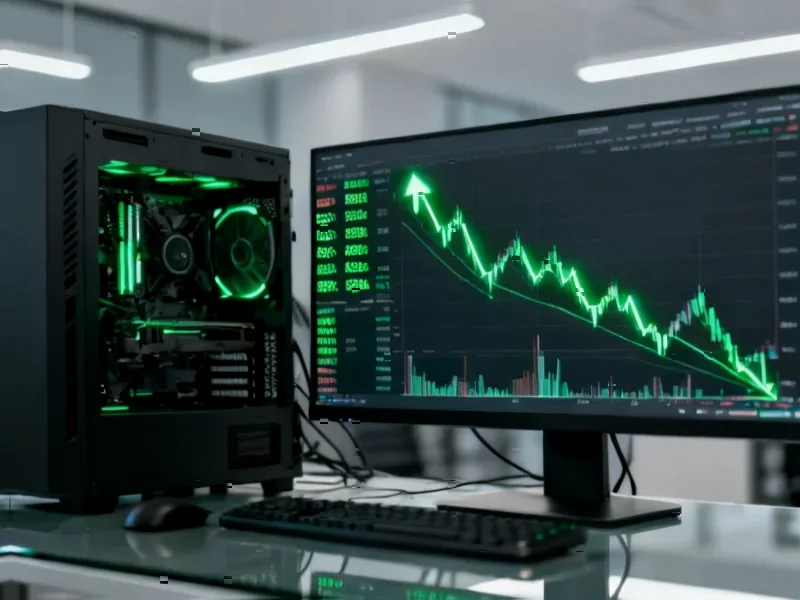According to CNBC, Wall Street analysts issued multiple significant upgrades and price target increases across technology, energy, and consumer sectors on Monday. Loop Capital reiterated Nvidia as a Buy and raised its price target to $350 from $250, citing expectations that GPU shipments will double over the next 12-15 months. UBS upgraded Cisco to Buy based on a “multi-year growth cycle driven by AI infrastructure demand,” while Wedbush increased Palantir’s price target to $230 ahead of earnings, calling the company an “AI juggernaut.” Other notable moves included Deutsche Bank raising Tesla’s price target to $470 ahead of this week’s shareholder vote, Piper Sandler upgrading Roku to Overweight with a $135 target, and Wells Fargo increasing JPMorgan’s target to $350. These analyst actions reflect growing confidence in sustained technology and infrastructure spending cycles.
The AI Infrastructure Bet Becomes More Concrete
The most striking pattern in these analyst moves is how AI infrastructure spending is now being framed as a multi-year phenomenon rather than a temporary surge. When UBS cites a “multi-year growth cycle driven by AI infrastructure demand” for Cisco, they’re essentially validating that enterprise and cloud providers are making long-term capital commitments to AI readiness. This represents a significant shift from earlier market views that treated AI infrastructure as experimental spending. The upgrade rationale suggests analysts see Cisco’s networking equipment as essential plumbing for the AI revolution, positioning the company to benefit from both corporate data center upgrades and cloud provider expansion simultaneously.
Nvidia’s Impending Shipment Surge Signals Broader Market Shift
Loop Capital’s prediction that Nvidia will “essentially double its unit shipments the next 12-15 months” represents more than just bullish sentiment on one company. This projection, if accurate, indicates that AI deployment is moving from pilot phases to production scaling across multiple industries. The magnitude of this expected ramp suggests that enterprises are moving beyond testing AI capabilities and are now building operational infrastructure to support AI-driven business processes. This has implications for power grid demands, data center construction timelines, and even cooling technology markets that support high-density computing. The shipment acceleration also implies that Nvidia’s competitors face an even higher barrier to entry as the company achieves greater economies of scale.
Palantir’s Transformation From Government Contractor to AI Platform
Wedbush’s increased price target for Palantir ahead of earnings reflects a fundamental repositioning of how the market values the company. The characterization of Palantir as an “AI juggernaut” rather than just a government contractor suggests analysts see their commercial business achieving escape velocity. More importantly, it indicates that Palantir’s platform approach to AI implementation is gaining traction against point-solution competitors. The earnings anticipation suggests the market is looking for evidence that Palantir can maintain its government business while scaling commercial adoption—a challenging balancing act that few defense contractors have managed successfully.
Broader Market Implications Beyond Technology
What’s particularly telling about these analyst moves is how AI infrastructure demand is creating ripple effects across seemingly unrelated sectors. Wells Fargo’s upgrade of Antero Resources specifically mentions “datacenter projects” and “gas supply deals” as catalysts, directly linking energy infrastructure to technology growth. This reflects a growing recognition that AI’s power requirements will strain existing energy grids and create new demand patterns for reliable electricity generation. Similarly, the multiple upgrades in industrial and materials companies suggest analysts anticipate broader economic benefits from the AI buildout beyond just the technology sector itself. The energy sector upgrades indicate that Wall Street is beginning to price in second-order effects of AI adoption that extend far beyond semiconductor manufacturers.
The Investment Strategy Shift From Speculation to Execution
These analyst actions collectively signal a maturation in how institutional investors are approaching AI opportunities. The focus has shifted from pure-play AI companies to established infrastructure providers that enable AI deployment at scale. This suggests a more pragmatic investment approach that prioritizes companies with proven revenue models and tangible AI-related business growth over speculative AI narratives. The concentration of upgrades in companies with clear paths to monetizing AI infrastructure—whether through networking equipment, energy supply, or enterprise software platforms—indicates that the market is moving from the “what if” phase of AI to the “how to” phase of implementation.




